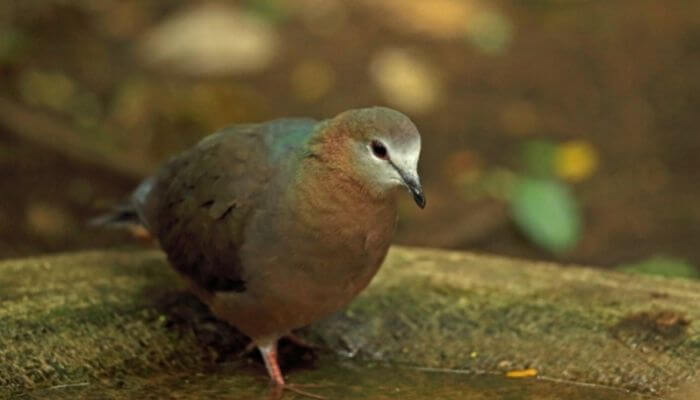Originating from Africa, lemon doves have quite an interesting life.
They live at high altitudes of up to 3000 meters, typically in the montane forests of sub-Saharan Africa.

The Origin Of Lemon Doves
Lemon doves are from the Columbidae family.
They originate from the Columba and Aplopelia genera, so they’re sometimes called Columba larvata or Aplopelia larvata.
You may also hear their other name: cinnamon doves.
Lemon doves are different from other Columba genus species, though, because of their terrestrial habits.

Hearing their name, you’d probably think they’re called that because they love lemons.
However, it’s more complicated than that.
The first Dutch settlers in South Africa used to refer to oranges by “lemoen.”
They found out that lemon doves come from forests to their orange trees, searching for food.
Therefore, they named lemon doves after the “lemoen” trees (orange trees).
Where Do Lemon Doves Live?
Lemon doves commonly live near the Southern African coast.
They spend most of their time in indigenous forests.
Additionally, a lot of them linger in isolated areas in southern sub-Saharan Africa forests.
Although lemon doves spread in southern and eastern South Africa, they prefer the eastern highlands of Zimbabwe and Mozambique.
That’s where their largest populations live.
They mainly feed on fallen fruit and seeds, so they therefore favor the Afromontane regions.
How Rare Are Lemon Doves?
According to the IUCN Red List, lemon doves aren’t among the highly threatened species in the world.
There are nearly 10,000 mature lemon doves spread across the globe, give or take.
So their numbers are stable for now.
In general, cinnamon doves are common in specific regions and rare in others.
For example, they’re not rare above 1300m in Nguu North Forest Reserve in Tanzania.
On the other hand, it’s rare to see them in lower areas.
You can spot them more frequently in near-coastal South Africa.
Lemons Doves Preferred Environment
As a forest-dwelling species, the lemon dove lives in bushes of evergreen forests.
Consequently, it rummages around lowland forests and leaf litter to find food.
On top of that, cinnamon doves tend to settle in moist, rural gardens and tropical forests in Africa.
They also usually drink at woodland streams.
That’s why they stay in wooded lands often.
Nesting Habitat
As for lemon doves’ nesting habitat, they often look for tree canopies to build their nests on.
That’s because they want to protect their nests from predators.
They’ll usually look for dense green foliage and branches to hide their nests.
Lemon Doves Appearance
The lemon dove is a dark medium-sized breed that has a pale face.
A cinnamon dove has a tail with pale gray corners.

It also has red feet, piercing red eyes, and orbital skin. Its bill is blackish and short, with a slight curve at the tip.
| Wingspan | Length | Weight | Coloring | |
|---|---|---|---|---|
| Average Lemon Dove | 30 – 38cm | 24 – 30cm | 81.7 – 150g | Cinnamon brown or greenish with white marks on the head |
| Average Feral Pigeon | 64 – 72cm | 32 – 37cm | 300 – 500g | Bluish grey with some black |
Most of these birds have a white-colored throat, bronze back, purple legs, and gray head.
It’s worth noting, though, that the appearance of cinnamon doves varies geographically.
The ones living in Eastern and Southern African ones have red underparts.
As for western and central African doves, their underparts are gray.
Concerning color, it differs according to the sex of a lemon dove.
Female lemon doves have a cinnamon-brown breast and brownish-gray plumage.
Their faces also have gray marks.
Males have greenish and glossed necks.
Lemon Dove Behavior
The lemon dove is completely harmless to humans.
Theories are it’s always been used to deliver love letters.
So, it’s usually associated with love and romance.
Lemon doves feed on insects, seeds, mollusks, and berries.
They forage in leaf litter, either solitarily or in pairs.
These birds are also shy, it is rare to notice their presence.
Lemon doves tend to build their nests using rootlets, twigs, and forest pine needles.
These doves build their nests high up in the tree canopy to protect their little ones from attackers.
Furthermore, they communicate using their voice like any other common ground dove.
They produce a loud, deep-hooted call to deliver their messages quickly.
Are There Other Pigeon Breeds Similar Or Related To Lemon Doves?
The answer is yes; however, they have some differences.
For example, ring-necked and African mourning doves share some similarities with lemon doves.
As for ring-necked doves, they have brownish-grey plumage and live in African and woodlands like lemon doves.
Both lemon doves and ring-necked doves feed on insects and seeds.
The females of the two pigeons lay off-white eggs and build their nests in trees.
What’s more, both African mourning doves and cinnamon doves have purple legs and live in South Africa and the woodlands.
However, lemon doves are distinctive in their terrestrial habits and colors.
Can You Domesticate Lemon Doves?
Lemon doves are loving and peaceful.
They have a unique ability to find their way even if it’s far.
However, it’s not common to keep cinnamon doves as a pet.
Despite their friendly attitude, they prefer the wildlife.
If you keep a lemon dove in a cage, you will decrease its lifespan.
Conclusion
Now, by knowing the peculiar features of lemon doves, you can easily identify them.
If you spotted a lemon dove in your garden, know that you’re lucky!
You’ll get to enjoy a beautiful view.
